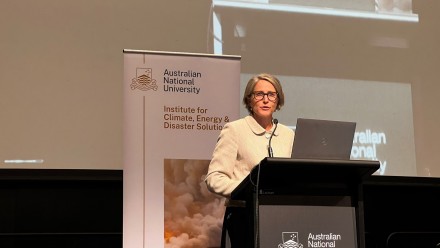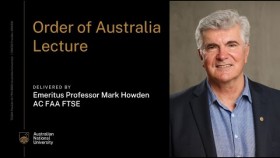Ambassador for Climate Change Keynote Address: ANU Climate Update 2023
Kristin Tilley, Australia's Ambassador for Climate Change, gave her first official speech in Australia at the ANU Climate Update 2023. Below is Ambassador Tilley's full keynote address.
Thank you Professor King for that introduction.
At the outset I’d like to acknowledge the very sad loss of Professor Will Steffen just last week. I had the pleasure of occasionally engaging with Will over the past 20 years and was extremely saddened by the news of his death. And I can only imagine the impact it is having on many of you, as long-standing colleagues, students and friends of Professor Steffen.
Thank you to the Australian National University for convening this event today. It is a great opportunity to discuss the state of our climate with a community of people committed to the challenge of tackling climate change.
And I am very honoured to be speaking here today – indeed my first official speech in Australia as Ambassador for Climate Change.
If I can impress upon you one key theme today, it is ‘opportunity’.
I do not need to recount for this audience, the urgency of the climate challenge. But, in the context of an update for 2023, I can speak to the opportunities presented through Australia’s renewed climate leadership.
Before I proceed, I too would like to acknowledge I am speaking today from Ngunnawal country and pay my respects to First Nations Peoples in the room or watching remotely. In particular, I’d like to recognise that First Nations Australians have used their traditional knowledge to adapt as Australia’s climate has changed over millennia, and acknowledge that the resilience of First Nations’ cultures is a source of inspiration for the Australian Government, including in our climate and foreign policies.
And this is critically important.
We know that climate change is having a disproportionate impact on First Nations’ Peoples worldwide with consequences for their cultures, traditional lands, and resources.
We also know that First Nations People have a wealth of experience and knowledge that will be critical in facing the global challenges of mitigating and adapting to the impacts of climate change.
More than 65,000 years of continuous practice preserving, sharing, and caring for resources on this continent, building knowledge of immense value to our climate action efforts today.
Australia’s efforts to respond to the global climate crisis – appropriately – start at home.
One of the first acts of the incoming Government was to increase Australia’s emissions reduction target to 43 per cent below 2005 levels by 2030 and confirm Australia’s commitment to our net zero by 2050 target in an updated Nationally Determined Contribution. In September, the Government enshrined both targets in legislation.
The Government has also committed to generate 82 per cent of Australia’s electricity from renewables by 2030.
This will be no small feat. Today, renewables make up just over one third of Australia’s electricity supply. So we have just 82 months – to borrow a regular refrain from the Climate Change Minister – to change that to 82 per cent.
The Government has introduced its Rewiring the Nation policy, to deliver a massive upgrade to our transmission infrastructure to bring on that new renewable energy generation.
But 82 per cent renewables in 2030 is not the final destination.
The National Energy Transformation Partnership, agreed by all the states and territories last August, sets out a roadmap to get to net zero in our energy network.
Passing electric vehicle tax cuts through Parliament and introducing fuel efficiency standards are also contributing to this momentum.
Australia’s domestic response applies across the economy. Industrial emitters are projected to overtake electricity generators as Australia’s leading source of emissions. That’s why the reformed Safeguard Mechanism, to come before Parliament in the coming months, will govern the emissions of our biggest industrial emitters, and require them to decrease – year-on-year, their emissions.
But Australia’s transition to a green economy, while ambitious and challenging, presents immense opportunities for regional growth, trade, and jobs as Australia becomes a renewable energy powerhouse.
We also know that our domestic efforts are responding to a challenge of international scale. And we know why global action is urgent and needs to be accelerated. Climate change impacts are no longer something we are seeking to avoid in the future. They are very much happening right now.
Last year, Pakistan received three times the annual average rainfall in only three months – inundating hundreds of villages, towns, and districts.
The Horn of Africa is currently facing its longest drought period in over 40 years – with 26 million people facing an acute food and livelihood crisis.
Closer to home, our important neighbour, Indonesia – the world’s largest archipelago – has tens of millions of citizens living in low lying areas exposed to sea level rise.
And of course Pacific Island Countries are on the front line. The economies, lives and cultures of our Pacific neighbours face unprecedented threat – and not just through rising sea levels.
Natural disasters – exacerbated by climate change – are taking an increasing toll. Pacific countries have a greater than 40 per cent chance of being struck by disaster each year, causing on average 14 per cent damage to GDP and affecting more than 10 per cent of the population.[1]
Salt water is invading fresh water supplies. Fish stocks – a staple source of food and incomes – are reducing.
So there are two points I would like to make here.
Firstly, as I’m sure you all know, climate change takes more than one state, one government, or one community to address. The global community will be much more successful in responding to climate change if we do so in partnership.
And secondly, Australia’s domestic experience and capability can and does have global impact.
We are building the tools and skills to help the global transition to net zero, and in particular in our region.
We have cutting-edge renewable technology. We have advanced carbon market mechanisms. We have emergency response personnel and forecasting systems trained and developed through our own experience responding to fires, floods, and cyclones. And we have institutions and individuals that are committed to helping others to respond to the climate crisis.
In Southeast Asia, we are collaborating with partners on an orderly transition to net-zero by 2050 and unlocking green trade and investment opportunities.
We are working with Indonesia to establish a new $200 million climate and infrastructure partnership.
We are pursuing new, innovative ways to facilitate trade and investment in environmental goods and services in the region and to develop standards to support regional decarbonisation efforts.
This includes a first-of-its-kind green economy agreement with Singapore, which will promote trade and investment across green economy sectors to assist both our nations to advance our net zero ambitions.
We are helping promote clean energy and green investment into the region and working with partners to strengthen infrastructure policy, planning and procurement. Australia is also working through innovative financing partnerships to deploy concessional investment to support climate projects and attract greater private investment.
Of course, a key region of importance for Australia’s international climate change engagement is the Pacific.
Australia is often the first to respond to disasters that occur in our region – for example, in providing emergency drought relief to Kiribati and Tuvalu last year.
We are partnering with national meteorological services in Vanuatu, Samoa, Niue and Solomon Islands to document traditional knowledge used for weather and climate forecasting – respecting Pacific Island Peoples’ historical and cultural understanding of their environment and its natural potential to adapt.
Pacific countries have called for international partners to be better joined-up on our efforts in the region.
We are listening – and working with fellow Partners in the Blue Pacific members – the US, UK, New Zealand, Germany, Japan, and Canada – to harness our collective strength through closer cooperation, led and guided by the Pacific Islands.
Australian climate leadership also means advocating for the unique position and needs of our Pacific family. We know that climate change is the single biggest threat to the livelihoods, security and wellbeing of the people of the Pacific.
That’s why we supported the inclusion of loss and damage funding on the agenda at COP27, and the agreement there to establish new funding arrangements. And we’ll be an active participant in the design of new loss and damage funds.
It’s also why Australia is bidding to host COP31 in 2026 in partnership with the Pacific.
Co-hosting with the Pacific is a unique opportunity to demonstrate our genuine solidarity with our Pacific family.
And COP 31 would provide a significant platform to showcase to the world Australia’s commitment to harnessing the opportunities that the global transition to net zero offers.
Opportunities to share our skills, knowledge and expertise.
Opportunities to build towards being a global renewable energy powerhouse.
Opportunities to put Pacific voices at the centre of international climate discussions.
Opportunities to galvanise action at home and at the international level in this critical decade.
In closing, I recall chatting to Will Steffen at an airport lounge many years ago – when I was en route to a climate change negotiation, and he was heading to Sweden to brief the royal family on climate science. What he said to me then is even more compelling today: “there’s no greater issue to spend your time working on.”
Thank you for having me here to speak as part of the 2023 Climate Update. I look forward to the stimulating discussion ahead.
[1] Source: WMO Atlas of Mortality and Economic Losses from We... | E-Library, 2021











